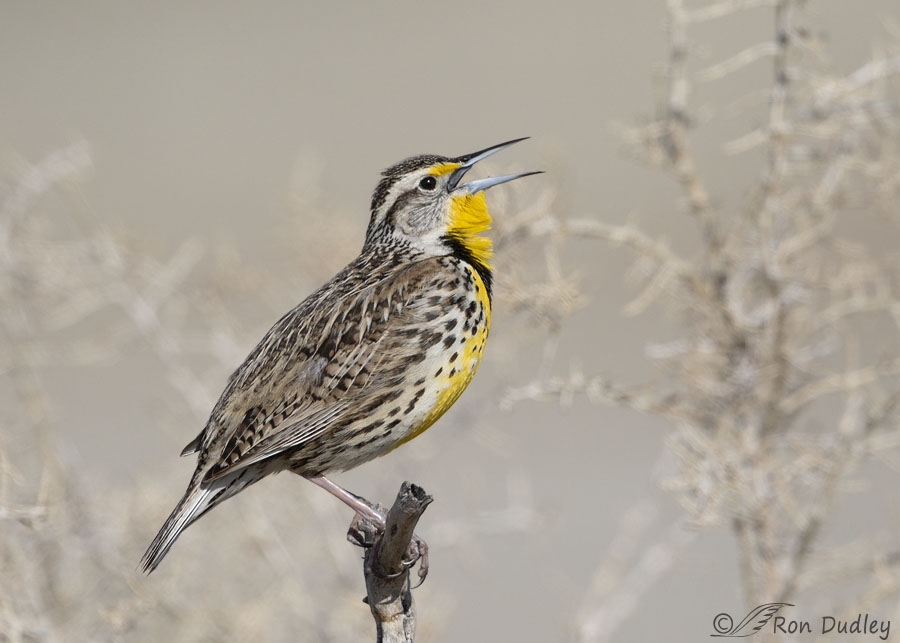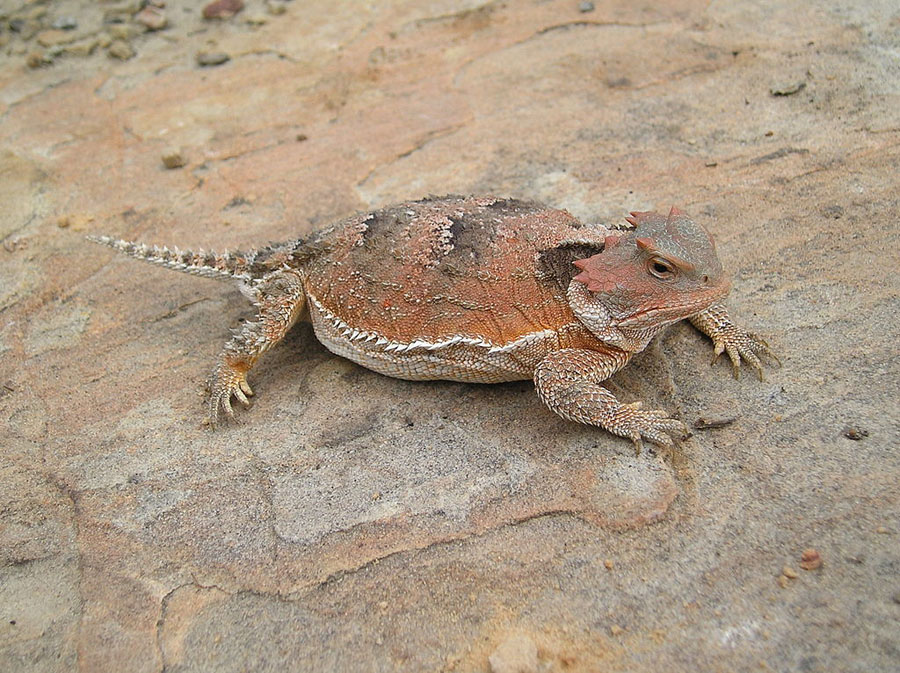And the problem with common names.

1/6400, f/6.3, ISO 500, Canon 7D Mark II, Canon EF 500mm f/4L IS II USM + EF 1.4 III Extender, not baited, set up or called in
Western Meadowlarks are beginning to sing reliably around here again but they’re still fairly difficult to approach so I don’t have any recent shots of them singing on territory. This photo was taken slightly more than a year ago on Antelope Island. This time of year we still don’t have any spring colors but I think that makes the bright yellows of this bird pop even more.
Yesterday I posted a photo of a Horned Lark and said they’re the “only member of the lark family that is native to the Americas.” That statement sort of became the elephant in the room because some readers immediately wondered … What about meadowlarks? Aren’t our native meadowlarks in the lark family?
In truth they aren’t. Meadowlarks are in the blackbird family, more closely related to Red-winged Blackbirds and grackles than Old World larks like the skylarks. Meadowlarks acquired their common name from their lark-like song prowess.
One of the problems with common names (as opposed to scientific names that are much more precise) is that they can be extremely misleading and confusing, even “irritating” as Lyle Anderson pointed out in yesterday’s post. Common names tend to be colloquial and based on “normal” language of everyday life. Another name for common names is “farmer names” so that should tell you something.
To impress upon my zoology students the value of scientific names and one of the weaknesses of common names I used to require them to memorize nine different regularly used common names for the mountain lion (there are actually many more than that) in addition to their single scientific name, Felis concolor.
The list of misleading common names is endless but it includes examples such as “starfish” (they aren’t fish), “sea horse” (they aren’t horses), “koala bears” (they aren’t bears), “ringworm” (it’s a fungus, not a worm) and “guinea pig” (they’re rodents, not pigs)

Image in Public Domain
One of my favorite examples is “horny toad” for horned lizards. Juvenile humor was a valuable tool for me while I was teaching high school so I used to tell my students that horny toads not only aren’t toads (they’re reptiles, not amphibians) but they’re presumably not unusually horny, at least in one commonly used sense of the word. That was a lesson my teenaged students nearly always remembered.
Jerry Seinfeld forged a mega-career out of pointing out some of the absurdities in our words and names, especially with his “What’s the deal with…? jokes. Here’s one of my favorites:
“Why do they call it a ‘building’? It looks like they’re finished. Why isn’t it a ‘built’?”
Gotta love Jerry.
Ron
Note: The cougar or mountain lion is listed in dictionaries under more names than any other animal in the world. Many of them can be seen here under “The Cat of Many Names.”


Interesting point about common names. I used to list some of the scientific names with my photos but it was a laborious task when I could only remember 3 letters at a time when copying them. Sad.
Jane, I tag scientific names in my posts for search engines so that’s been a big help in remembering them because each time I have to type them out and if I don’t know them I have to look them up.
I can hear that Western Meadowlark singing in the photo. And I’ve never even heard one

When talking botanically to plant people/friends where we have been used to alternating common and Latin names, I’m finding that rapid changes due to molecular systematics have made many common names more useful/familiar than the new Latin names.
At least English names have common pronunciations. Ask a handful of people to pronounce the Latin name of any species and you’ll probably get at least a couple of variations.
And we don’t have to worry about dogs and cats and other domestic animals. People have bred the Latin names right out of ’em.
“People have bred the Latin names right out of ’em.”
That one made me LOL, Lyle.
Hi Ron,
I concur with your thoughts on ‘common names’ – as a teacher and a scientist they drive me mad.
I also concur with your thoughts on Jerry Seinfeld – he is the only US comedian this Australian ever really found amusing.
Thanks, Gary. We’re two out of two.
What would TCU do without their Purple Horned Frog? “Killer Frogs!”
I used to have those same conversations with my students — especially when it turned out that new evidence put a scientific name into question. I’m still sore that taxonomy (and botany!) was removed from the high school science curriculum in favor of more biochemistry and molecular genetics. 9th and 10th graders don’t need to memorize the Krebs Cycle and OxPhos!!! (Grrrrr!!!!!)
Besides, I couldn’t use one my favorite mnemonics: Kids Playing Catch On Freeways Get Smashed.
Marty, I remember it as “Kinky People Coming Over For Great Sex.”
I didn’t use it in class though…
Science people come up with the best dirty mnemonics! Since this is a family show, I’ll skip the bones of the hand and the facial nerves…
Very nice soft background yet detail of the environment. It makes the colors on the bird pop.
They are singing now but jumpy. I will have a bit more available time soon so I hope to get some nice photos of them before the gnats hatch,
“I will have a bit more available time soon”
I hope that means what I think it might, April.
What an entertaining and educational post this morning. Kids interpretations often add to the enjoyment of things.
Sounds like you a re feeling better and here is a wish for you to continue to do so.
Thanks, Betty. If I’m feeling poorly enough to lose my (juvenile) sense of humor I’m in pretty bad shape.
At least in birds, English names (a term I prefer to “common name”) are standarized as long as you follow some rules. To properly refer to a specific bird the name must be capitalized. (I know that journalists don’t agree). For example, a yellow warbler could refer to many different warblers as many species are yellow. But Yellow Warbler refers only to the bird whose Latin name is Setophaga petechia. There are numerous other examples. Unfortunately, no other animals or plants have this standardization except for Latin names.
With regard to Western Meadowlark, readers may enjoy this tidbit. Its Latin naame is Sternella neglecta. It looks very much like the Eastrn Meadowlark and Lewis and Clark, Townsend and some other early explorers made no distinction and simply referred to both species as “Meadowlark”. Audubon recognized that there were really two species and named our Western Meadowlark S. neglecta because it was neglected by earlier explorers.
Dan, I was just reading that bit of history about Lewis and Clark and meadowlarks this morning.
Spring is starting to get sprung…daffy dills up and Meadowlarks
singing…must be around the corner…very little snow this winter…not too healthy,,,we need cold to kill off the “bad bugs”…and need snow melt water…
“daffy dills” – another one!
Daffy dills are among my favorite flowers!
I am pretty certain that your students STILL remember the horny toad lesson.
I will add magpies to your list. Our magpies are not members of the corvid family, though they have similar cheeky characteristics.
Many of them probably do, EC. We had fun with it.
Love those meadowlarks! Never knew they were related to grackles.
Yup, orioles and cowbirds too.
Wow, Ron–your sense of humor is in full recovery this AM–here’s hoping
your neck is in as good a state ! Picturing your students’ faces as you
delivered your “Horny Toad” message made me laugh out loud–that was
a great example to help them remember the point you were making about
common names ! Thanks for the lesson about “lark relatives”—that’s a
surprise to me, and very interesting……
Kris, My sense of humor probably was (is) as juvenile as theirs because I enjoyed it easily as much as they did…
Fun post this morning. Yes, as a high school boy I definitely would have laughed at the “horny” toad teaching. And fond memories of Jerry’s humor. My wife Margaret went back to school at Cal Poly in her 40’s and got her degree in Horticulture. We used to take her scientific plant name cards out hiking with us and I would read out descriptions of plants and trees while she would answer with the scientific name. We have lots of Meadowlarks right now although at this point not easy to approach. My experience has always been that later in the season they will be much more likely to pose for photos. Only 19 days till spring.
Good for Margaret for going back for her degree in her 40’s. That takes, among other things, strength of character. Kudos to her!
Beautiful Meadowlark….. “Common” names are a problem and challenging at times both in plants and animals. I was an adult before I really figured that one out and it took awhile (and a bit of research) to figure out “Indian Tobacco” here at the farm was really “Mullein”. At the same time I find once I’ve “learned” something as one thing it becomes a challenge to “change” – even with buildings and street names.
“Common” names are a problem and challenging at times both in plants and animals. I was an adult before I really figured that one out and it took awhile (and a bit of research) to figure out “Indian Tobacco” here at the farm was really “Mullein”. At the same time I find once I’ve “learned” something as one thing it becomes a challenge to “change” – even with buildings and street names.  I love the “horned toad” example you used for teenagers!
I love the “horned toad” example you used for teenagers! 
Judy, I find “change” difficult too. For me (and I’ll bet for you) gopher always comes to mind before Richardson’s ground squirrel.
Yep!